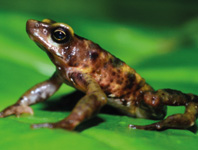Abstract
The Neotropical toads of the genus Atelopus are among the most imperiled of all amphibians (La Marca et al. 2005; Gonzalez-Maya et al. 2013; McCaffery et al. 2015). Nowadays, at least 90% of the 93 listed species are threatened and more than 77% are Critically Endangered (McCaffery et al. 2015; IUCN 2016). Colombia has 44 described species of Atelopus (Frost 2017), two of these are categorized as extinct (EX) by the IUCN (2016): A. ignescens and A. longirostris, although they were recently re-discovered in Ecuador (Tapia et al. 2017), 34 as critical endangered (CR), four as endangered (EN), two as vulnerable (VU), one species has data deficient (DD) and another one has not been evaluated. Atelopus subornatus Werner, 1899, is an endemic Colombian harlequin toad described from 2300 to 2800 m.a.s.l in the municipalities of Sibaté (Alto de Sibaté and Agua Bonita) and Fusagasuga (above Fusagasuga and Tierra Negra), in Cundinamarca (Fig. 1A), on the western flank from Cordillera Oriental of Colombia (Werner 1899; Lynch 1986; Lötters 1989, 1992). The last record of this species was in 1993 (Lötters 2005), and it currently is listed as Critically Endangered by the IUCN (2016). Herein, we report the rediscovery of A. subornatus at a new locality from Tolima, Colombia (Fig. 1A), and redescribe its tadpole. The determination of the species was based on comparisons with material deposited in the amphibian collection of the Instituto de Ciencias Naturales, Universidad Nacional de Colombia (ICN-UNAL) for all species of Atelopus reported from the same general area in Cundinamarca and relatively similar to A. subornatus. The specimens are housed in the Herpetological collection of the Tolima University (CZUT-A) and amphibian collection of ICN-UNAL.
References
Frost, D.R. (2017) Amphibian Species of the World: an Online Reference. Version 6.0. Available from: http://research.amnh.org/vz/herpetology/amphibia (accessed 23 March 2017)
Gonzalez-Maya, J.F., Belant, J.L., Wyatt, S.A., Schipper, J., Cardenal, J., Corrales, D., Cruz-Lizano, I., Hoepker, A., Escobedo-Galván, A.H., Castañeda, F. & Fischer, A. (2013) Renewing hope: The rediscovery of Atelopus varius in Costa Rica. Amphibia-Reptilia, 34, 573–578.
https://doi.org/10.1163/15685381-00002910Gosner, L. (1960) A simplified table for staging anuran embryos and larvae with notes on identifications. Herpetologica, 16, 183–190.
IUCN (2016) The IUCN Red List of Threatened Species. Version 2016-3. Available from: http://www.iucnredlist.org (accessed 24 March 2017)
La Marca, E., Lips, K.R., Lötters, S., Puschendorf, R., Ibáñez, R., Rueda-Almonacid, J.V., Schulte, R., Marty, C., Castro, F., Manzanilla-Puppo, J., García-Pérez, J.E., Bolaños, F., Chaves, G., Pounds, J.A., J.A. Toral, E. & Young, B.E. (2005) Catastrophic population declines and extinctions in Neotropical harlequin frogs (Bufonidae: Atelopus). Biotropica, 37 (2), 190–201.
https://doi.org/10.1111/j.1744-7429.2005.00026.xLötters, S. (1989) Revalidierung von Atelopus subornatus Werner, 1899. Salamandra, 25, 281–290.
Lötters, S. (1992) Zur Lebendfärbung von Atelopus subornatus Werner, 1899. Salamandra, 28, 89–91.
Lötters, S. (2005) Arlequín vientre de fuego, Atelopus subornatus. In: Rueda-Almonacid, J.V., Rodríguez-Mahecha, J.V., La Marca, E., Lötters, S., Kahn, T. & Angulo, A. (Eds.), Ranas Arlequines. Conservación Internacional, Bogotá, pp. 113.
Lynch, J.D. (1986) Notes on the reproductive biology of Atelopus subornatus. Journal of Herpetology, 20, 126–129.
https://doi.org/10.2307/1564145McCaffery, R., Richards-Zawacki, C.L. & Lips, K.R. (2015) The demography of Atelopus decline: Harlequin frog survival and abundance in central Panama prior to and during a disease outbreak. Global Ecology and Conservation, 4, 232–242.
https://doi.org/10.1016/j.gecco.2015.07.003Tapia, E.E., Coloma, L.A., Pazmiño-Otamendi, G. & Peñafiel, N. (2017) Rediscovery of the nearly extinct longnose harlequin frog Atelopus longirostris (Bufonidae) in Junín , Imbabura, Ecuador. Neotropical Biodiversity, 3, 157–167.
https://doi.org/10.1080/23766808.2017.1327000Werner, F. (1899) Über Reptilien und Batrachier aus Columbien und Trinidad. Verhandlungen des Zoologisch.-Botanischen Vereins in Wien, 49, 470–484.

